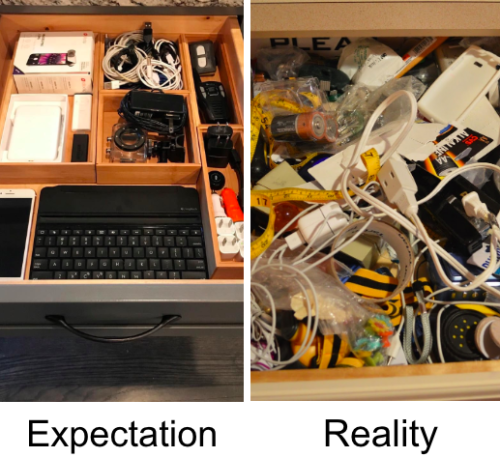We all have that one drawer at home that we dread to open. Crammed with tangled cables, fused light bulbs, and lethal batteries from five years ago. Okay, ten years ago.

The good news is you don’t need to be a home-science guru to get rid of your old electronics, lights and cables — a.k.a e-waste.
Here’s how you can manage your e-waste in the easiest and most responsible way.
I. Know Your Electronics
Based on size and toxicity, you can classify your electronic and electrical waste into three broad categories:
- Bulky: Fridges, washing machines, or anything too big to carry to a public disposal centre yourself.
- Hazardous: Tubelights, light bulbs, toner cartridges, batteries, monitors and screens. Anything with a chemical component. Laptops and phones are excluded from this category even though they have batteries, unless the battery has bloated due to over-heating.
- Non-hazardous: Cables, chargers, microwaves, gadgets like laptops and phones. Delete your data from your gadgets before getting rid of them.
Pro-tip: When in doubt, assume the worst.
II. To Store Or Not To Store
It’s best to get rid of e-waste as and when it is generated. But if you’re unable to dispose of the waste promptly, it is fine to store it safely at home and dispose of it on a weekly or monthly basis.
Store lights, batteries and other hazardous waste separately. Make sure they don’t contaminate anything in your house or other waste.
If a tube light or a light bulb breaks, do not use your mop to clean up the glass pieces or liquid chemicals. Instead, use cardboard or a rag that you dispose of with the broken light as soon as possible.
III. Disposal
There are several ways to dispose of e-waste depending on its type. Here are a few of the options available in India:
1. Drop-Off Bins
Several cities now have public e-waste drop-off points run by various NGOs and CSR initiatives, where you can dump your e-waste. For example, these bright yellow bins by SAAHAS can be found at various spots in Bengaluru, Chennai, and other cities. A quick Google search will help you find the nearest drop-off point in your city.
This option is only for non-hazardous waste like laptops and cables. Do not throw batteries or lights in these bins as the built-up pressure and heat on chemical components can cause explosions.
2. E-Waste Collection Centres
Alternatively, you can take your junk electronics to an e-waste collection centre in your city. This is, in fact, the best way to dispose of hazardous waste. Inform the attendant at the centre if you have any hazardous items.
3. Call an E-Waste Collection Service.
Many NGOs also provide door-to-door collection of e-waste. Contact them for a one-time pick-up or routine collections. This makes for a super-convenient disposal option that you can organise for your society or neighbourhood.
4. Producers & Online Retailers
Whenever possible, exchange or return your old gadgets when you get a new one. Brands, manufacturers and online marketplaces – such as Amazon and Flipkart – accept your old electronics. Keep an eye out for offers like those. This is the best way to get rid of your fridge and washing machine.
To get you started, here are a few e-waste service providers:
- BMC E-Waste Centre (Mumbai): 1800-102-1020
- SAAHAS (Bengaluru & Other Indian Cities) : 7349737586
- Croma E-Care (Across India): 7207666000
- Namo E-Wate (Delhi): 1800-123-512
It comes down to this – How important is our health and our environment? We have the world’s most polluted cities. As consumers, we should embrace our responsibilities. And the producers too must embrace their responsibilities. Because solutions do exist.
Share this “how-to” with your friends & family
Share on facebook
Facebook
Share on twitter
Twitter
Share on linkedin
LinkedIn
If you found our stories insightful, informative, or even just enjoyable, we invite you to consider making a voluntary payment to support the work we do at The Better India. Your contribution helps us continue producing quality content that educates, inspires, and drives positive change.
Choose one of the payment options below for your contribution-
By paying for the stories you value, you directly contribute to sustaining our efforts focused on making a difference in the world. Together, let's ensure that impactful stories continue to be told and shared, enriching lives and communities alike.
Thank you for your support. Here are some frequently asked questions you might find helpful to know why you are contributing?

